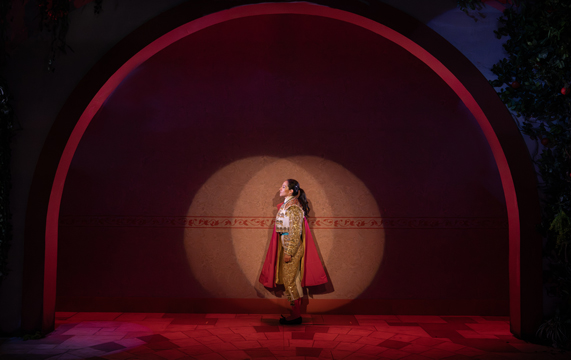A Study of Self Realization
By Alix Cohen
Bullfighting in Mexico, corrida de toros, was introduced during the colonial era by Spanish settlers and evolved into a national tradition. For centuries, it’s been celebrated as a ritualized spectacle blending athleticism, choreography, and confrontation between man and beast.
Though female toreros have fought since the 17th century, they’re few and far between. Latin custom sees the ring as a place to exhibit hyper masculinity and women as homemakers. Barriers for women toreras include family discouragement, limited sponsorship and lingering sexism.
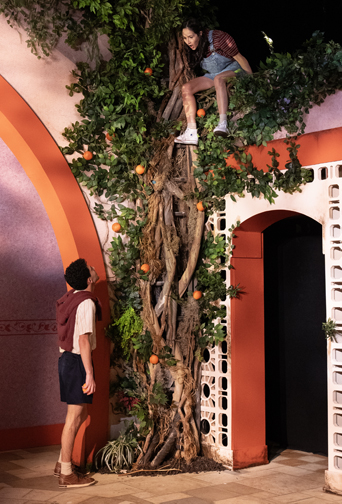
Jacqueline Guillen (Elena) and Jared Machado (Tanok)
The play takes place in Yucatán when bullfighting was still to the death and not, as it is today in Mexico City, bloodless.
Tomboy Elena Ramirez (Jacqueline Guillen) secretly dreams of being a Torera. She’s been surrounded by the culture and tradition all her life. Her father died in the ring saving the life of retired rejoneador (Matador on a horse), Don Rafael (Jorge Cordova).
Her mother, Pastora (Elena Hurst), was nanny to Don Rafael’s now teenage son, Tanok. (Jared Machado). Having raised the kids together, she treats them both as her own, remaining housekeeper and cook to the family. “The kitchen has to be a dance,” she tells Elena, hoping she’ll be drawn to the pleasure of cooking.
The girl is expected to marry. Instead, Elena climbs orange trees – “I’ll never fall. “I am a bird. I am invincible. I soar above everything.” (On set climbing enhances.) At night, she clandestinely garners what little training she can from Tanok who’s begun lessons for the ring.
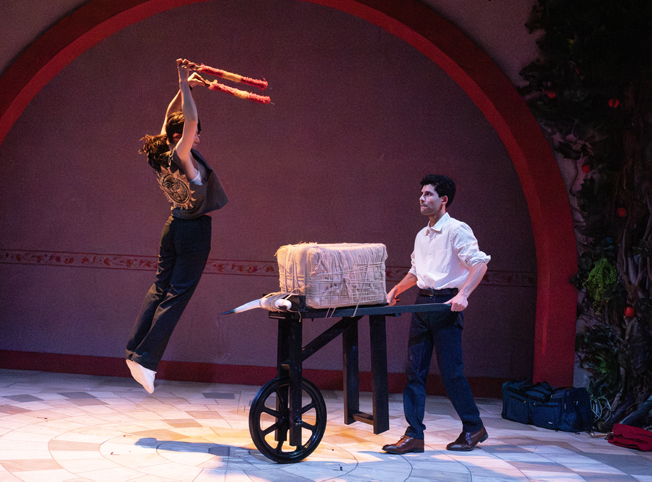
Jacqueline Guillen (Elena) and Jared Machado (Tanok)
Elena has natural grace and instincts, whereas Tanok has to work harder to achieve them and hopefully please his strict father. When he invites her to watch him, the boy loses focus. Don Rafael sends Elena away. It’s clear that ignoring class distinction, the kids are devoted, and in love.
Over the course of 18 years, Tanok begins to both literally and figuratively shine in the ring. Costumes (Rodrigo Muño) include several glorious traje de luces = matador “suits of light” as well as immensely creative (Human) horses and bulls. Prop Master/Fabricator Red Kadetsky contributes proper capes and swords as well as civilian props. Feel of authenticity is pervasive.
Now in her twenties, the heroine has settled for being Tanok’s mozo de espadas, the assistant who dresses him, cares for weaponry, and manages travel. He never stops encouraging Elena to spread her wings. They finally see each other as adults in charge of their own destinies.
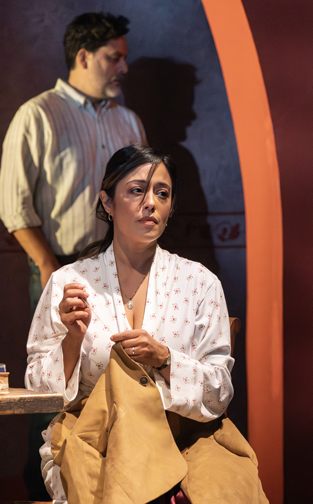
Jorge Cordova (Don Rafael) & Elena Hurst (Pastora)
With his help, Elena assumes tomar la alternativa (literally “to take the alternative”), stepping into the responsibility, danger, and prestige of a torero into the ring. Tragedy ensues. At the same time as Elena, the audience learns something new about her heritage. (I picked it up early on.)
Manifestation of what began on the page is highly imaginative.Two dancers create a horse, one becomes a bull. Not feeling they had enough to do, perhaps, the company employs them to dance while moving sets. It’s gratuitous, not evocative, and except for two instances, dissipates drama:
After the tragedy, Pastora and Don Rafael look across the courtyard sharing despair. When the dancers perform here, it maintains mood. (Andrea Soto and Christian Jesus Galvis) A later solo expresses unspoken feelings.
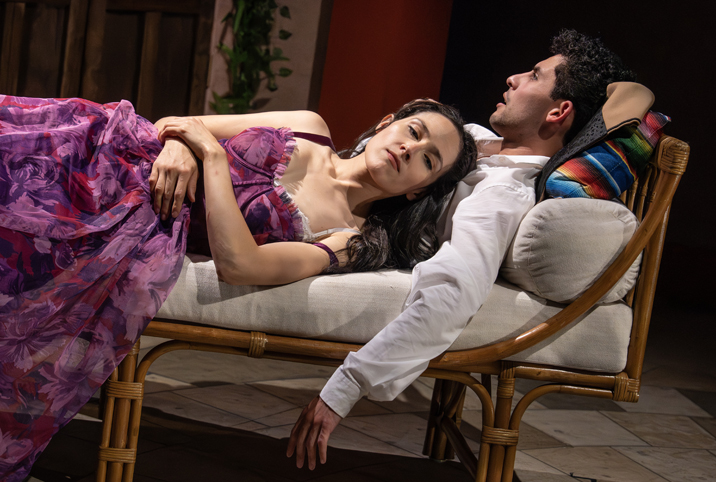
Jacqueline Guillen (Elena) and Jared Machado (Tanok)
Direction (Tatania Pandiani) is otherwise expert. The four characters have divergent personalities. As they grow older, both Elena and Tanok assume very different bearing. Gradual nature of change in physicality towards each other is unmistakable. (Co-Movement & Intimacy Directors- Carter Gill, Skye Bronfenbrenner) Pride and exhilaration beam. Death guts (It’s a verb-no pun intended.)
Bullfighting Consultant Rodrigo Ortiz provides traditional cape and matador choreography. Watching the actors rise to their toes, inhale and passionately pierce the bull is the epitome of concentration as is the balletic sequence of approach.
Elena Hurst’s Pastora is consistently warm and sensual. The actress sings and moves appealingly. Emotions have roots.
As Don Rafael, Jorge Cordova is stubborn, proud, and guilt-ridden, yet lacks believability in spurts to quick temper and longing.
Jared Machado (Tanok) appears to morph from tremulous boy to confident young man before our eyes. Adoration of Elena is palpable.
Jacqueline Guillen’s (Elena) tomboy persona is one of the best I’ve seen. The actress resembles a young racehorse, testing the tools of competition. Petulance, hope, and admiration are pristine.
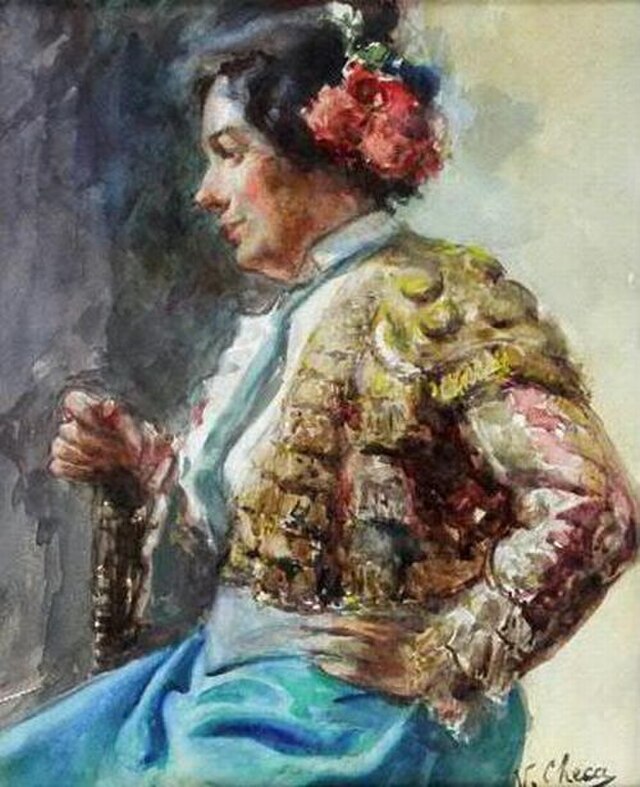
“La Martina”, a painting by Ulpiano Checa depicting female bullfighter Martina García (Public Domain)
The marvelous Mexican patio is surrounded by arches, foliage, and ornamental, cement lattice. A balcony is selectively occupied. A carretón, the training device simulating the head and horns of a bull mounted on a wheeled frame, is evocative. (Emmie Fink)
Sound Design and Composition (G. Clausen) encompasses a great variety of traditional music and song chosen for its aptness to a scene.
A glimpse at bullfighting: the film Blood and Sand with Tyrone Power, Hemingway’s rhapsodic prose Death in the Afternoon or novel The Sun Also Rises.
Photos by Joan Marcus
Torera by Monet Hurst-Mendoza
Directed and Choreographed by Tatiana Pandiani
Through October 19, 2025
WP Theater 2162 Broadway, at 76th Street
wptheater.org.

